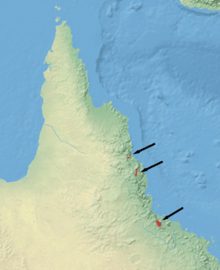Northern bettong
The northern bettong (Bettongia tropica) is a small potoroid marsupial which is restricted to some areas of mixed open Eucalyptus woodlands and Allocasuarina forests bordering rainforests in far northeastern Queensland, Australia. They are known as "rat kangaroos" and move about in a slow hopping manner. There are five different species in Australia of this particular animal. It is about the size of a rabbit with a large tail dragging behind.
| Northern bettong[1] | |
|---|---|
| Scientific classification | |
| Kingdom: | Animalia |
| Phylum: | Chordata |
| Class: | Mammalia |
| Infraclass: | Marsupialia |
| Order: | Diprotodontia |
| Family: | Potoroidae |
| Genus: | Bettongia |
| Species: | B. tropica |
| Binomial name | |
| Bettongia tropica Wakefield, 1967.[3] | |
 | |
| Distribution of the northern bettong | |
Lifespan:
The typical bettong lives in the wild for about 4 to 6 years. This is a very short life span, but according to the Smithsonian's National Zoologist, they can, under proper care, live up to the age of 15 years.[4]
The most common bettong is the Rufous Bettong and are found along the eastern coast of Australia.[5]
Behavior of the bettong:
All species of the bettong are nocturnal. They carry nesting materials with their long tails and can be found in underground borrows that they escape to during the day. They like to feed at night and their range of food varies. They rarely drink water, and refrain from eating any green plants. They primarily seek fungus based plants such as mushrooms, tubers, scrubs, fruits and seeds. They use their front claws to dig for tubers identifying them via their sense of smell.[4] These animals are able to reproduce at any time of the year, and can produce three young in a favorable year. This high rate of reproduction can lead to fluctuations in population growth.[5]
Threats:
The bettong is a solitary and faces major threats. From land clearing they have experienced an extreme loss of habitat. Vast expansion in agriculture has caused a major threat in its food sources.[5] It spends the day in a well concealed nest constructed beneath a tree, within a clump of grass or in other litter collected at ground level. Nesting material is carried using its prehensile tail. Ectomycorrhizal fungal sporocarps are the staple diet of the northern bettong. These are dug from beneath the soil at the bases of trees, and work to date suggests substantial nightly movements are often required to detect this irregularly-distributed food source. Other foods in the diet include grass roots and tubers, lilies, herbs, and sedges. The northern bettong appears to breed all year round, and like other relatives of the kangaroos, the joey is carried in a pouch until it is old enough to follow the mother as a 'young-at-foot'.
The northern bettong is an endangered animal, and only populates three regions of Queensland, Australia, Davies Creek, Emu Creek and Tinaroo Creek all of which are within 80 miles of each other.[6]
References
- Groves, C.P. (2005). Wilson, D.E.; Reeder, D.M. (eds.). Mammal Species of the World: A Taxonomic and Geographic Reference (3rd ed.). Baltimore: Johns Hopkins University Press. pp. 57–58. ISBN 0-801-88221-4. OCLC 62265494.
- Burnett, S. & Winter, J. (2008). "Bettongia tropica". IUCN Red List of Threatened Species. 2008. Retrieved 29 December 2008.CS1 maint: ref=harv (link) Database entry includes justification for why this species is listed as endangered
- Wakefield, N.A. (1967). "Some taxonomie revision in the Australian marsupial genus Bettongia (Macropodidae), with description of a new species". The Victorian Naturalist. 84: 8–22.
- "Brush-tailed bettong". Smithsonian's National Zoo. Retrieved 2018-04-28.
- "Bettongs (Rat Kangaroos) - Bush Heritage Australia". Bush Heritage Australia. Retrieved 2018-04-28.
- Whitehead, Tegan Carla (2018). Population trends, habitat requirements and conservation recommendations for an endangered marsupial, the northern bettong (Bettongia tropica) (phd thesis). James Cook University. doi:10.25903/5d0ab9e4fe2eb.
External links
- https://web.archive.org/web/20060507141401/http://www.australianfauna.com/northernbettong.php
- https://web.archive.org/web/20060615052224/http://www.jcu.edu.au/school/tbiol/zoology/auxillry/mammals/bettong.htm
